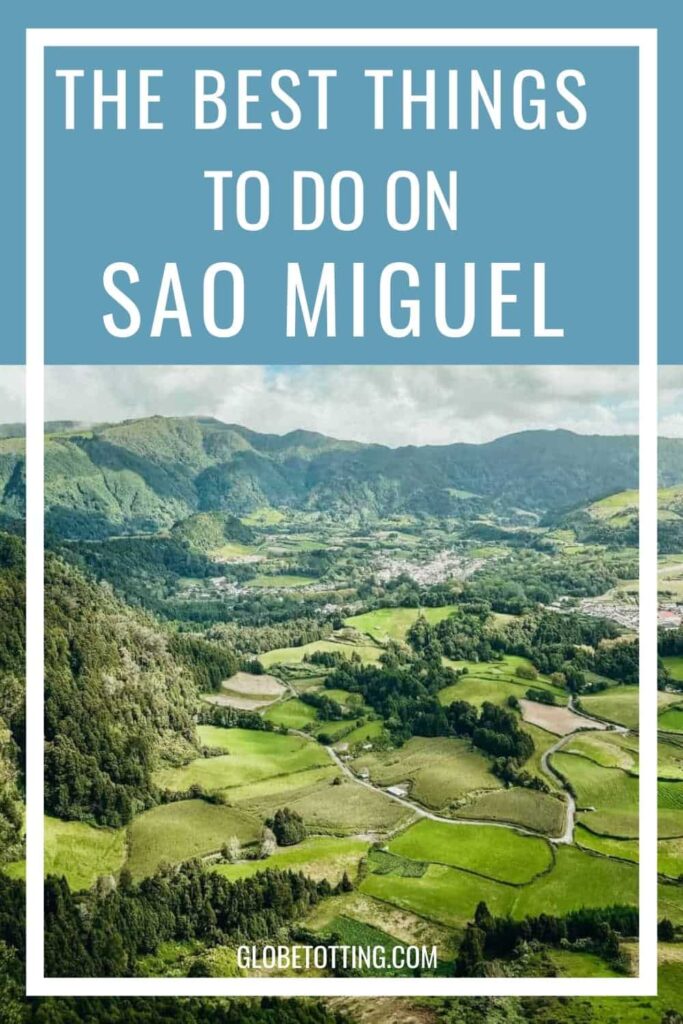Sao Miguel is the largest, most populated and most volcanically active of the nine Azores Islands, the Portuguese archipelago that sit in the middle of the Atlantic Ocean. It’s famous for its dramatic volcanic scenery, its beautiful hydrangeas, its rich marine life and, increasingly, for its exciting adventure activities.
This is the ideal island getaway if you’re looking for something a little different. Although the Azores have been popular with mainland Portuguese for a long time, the islands haven’t really been on the international travel radar until now.
Sao Miguel is the most visited of the nine islands and is a great place to start your holiday to the Azores Islands. This is not, however, the place to come if you’re looking for an all-inclusive resort holiday with long days lazing on sandy beaches. Instead, Sao Miguel is the place to come to really immerse yourself in nature, to enjoy spellbinding scenery and to spend lots of time in the Great Outdoors.
Nicknamed the Ilha Verde, the ‘Green Island’, Sao Miguel is lush and green in places and wild and stark in others, where the volcanic rock has formed dramatic shapes. It’s a curious mix between Iceland, Wales and Hawaii and absolutely beautiful.
There is a lot to see and do on Sao Miguel from some spectacular hikes and dramatic views to whale and dolphin watching opportunities, and canyoning, coasteering, kayaking and more. Discover more things to do on Sao Miguel here.
If you are considering a holiday to Sao Miguel then this post shares the best places to visit on the island.
Disclosure: I was a guest of EPIC Travel for the purpose of creating this guide. This post may contain affiliate links. I have been or could be if you click on a link in this post compensated via a cash payment, gift or something else of value for writing this post. See our full disclosure policy for more details.
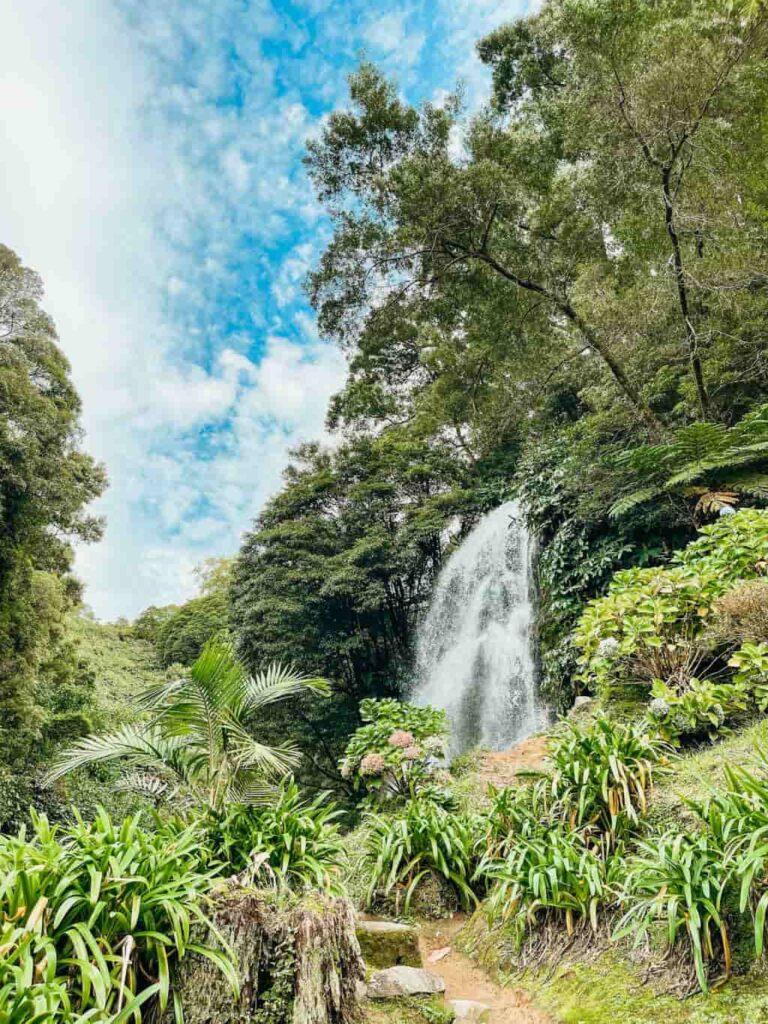
How long should you spend on Sao Miguel?
Table of Contents
I had four days and three nights on São Miguel island and it was enough to see most of the sights on the island but it wasn’t enough time to enjoy the many activities on offer. I would recommend a week to really enjoy everything that Sao Miguel has to offer.
If you’re interested in visiting some of the other Azores Islands while you are here then do take a look at my guide to planning a holiday in the Azores, which also shares details on EPIC Travel, the excellent travel agency that I travelled with to the Azores. They can advise on the best way to enjoy both Sao Miguel island and the Azores as a whole.
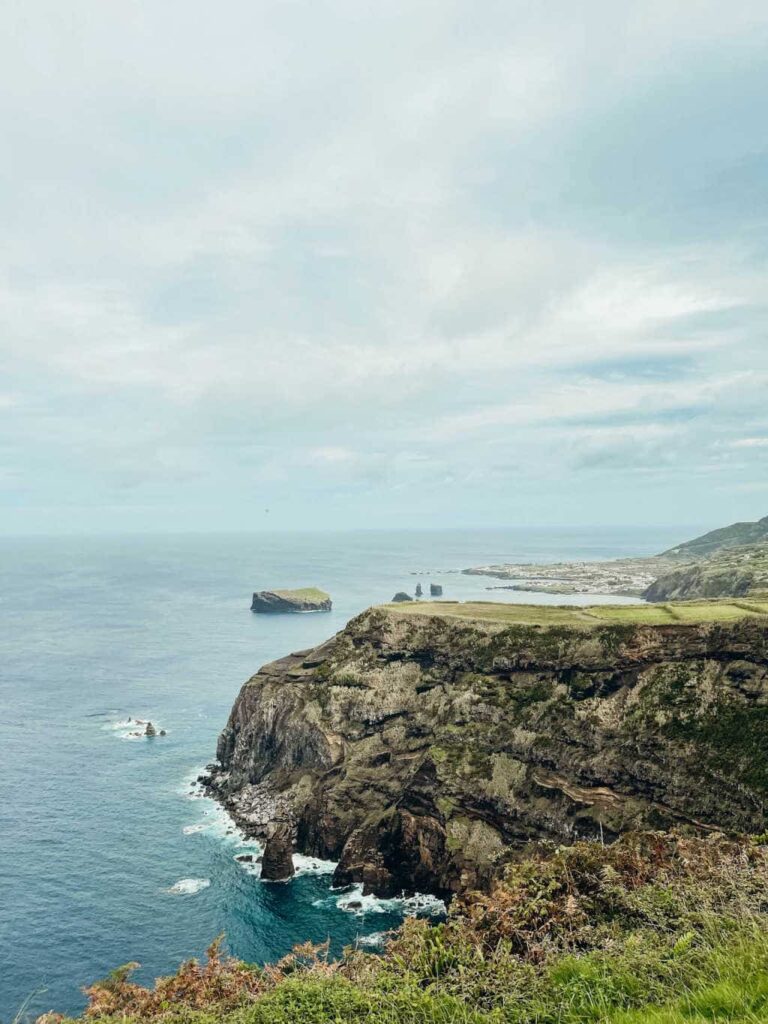
You may also enjoy these posts on Portugal:
- 23 great things to do in Lisbon with kids
- Why visiting Madeira with kids is fun for the whole family
- The 17 best things to do on São Miguel island
- How to plan the perfect holiday to the Azores
- 11 of the best shops in Lisbon
If you’re planning to explore more of Portugal then don’t miss these things to do in Alentejo, the Douro Valley and Porto.
Where to stay in Sao Miguel
Sao Miguel is the largest island in Azores measuring 5km long and 15km wide. Its size means that you can easily explore all that the island has to offer (providing you have the time). That said, it’s big enough to warrant staying in at least a couple of different locations rather than basing yourself in one place.
The following recommended hotels are marked in yellow on the map above.
Ponta Delgada is the island’s capital and where the International airport is. It’s also where transatlantic cruises dock on their journeys across the ocean. It is possible to base yourself in Ponta Delgada and take day trips or organised day tour from here but you will be missing out on much of the island’s magic.
We stayed in the Azor Hotel in Ponta Delgada, a large, modern hotel overlooking the port. Rooms are very spacious and come with a harbour-facing balcony. There’s also a very good restaurant and a swimming pool, and you are a quick walk away from the centre of town.
The Furnas Boutique Hotel, located in Furnas, is a good option for exploring the east of the island. This hotel is in the process of being updated and renovated but what it lacks in, for example, room size (they are compact), it more than makes up for in service. The staff and hotel manager are outstanding, greeting guests by name, hosting daily activities, suggesting things to do in the area and more. The hotel also has its own spa and natural pools heated by geothermal activity.
The Santa Barbara Eco Resort is the third hotel that we stayed in and was my favourite. This is a beautiful hotel that enjoys a cool, modern design aesthetic. Located in Ribeira Grande in the north of the island, there are a huge variety of rooms on offer plus swimming pools, direct beach access and a very good restaurant. Again, the staff here could not have been more helpful.
I discovered these hotels courtesy of EPIC Travel, the boutique travel agency that organised by trip to the Azores. Their travel experts live in-country allowing them to create bespoke itineraries that are entirely tailored to what you want to do. They are particularly good at finding interesting and unique hotels and have very good connections with the properties.
If you are interested in speaking to EPIC then let them know that you heard about them through globetotting and you will receive a VIP Welcome Gift as a thank you.
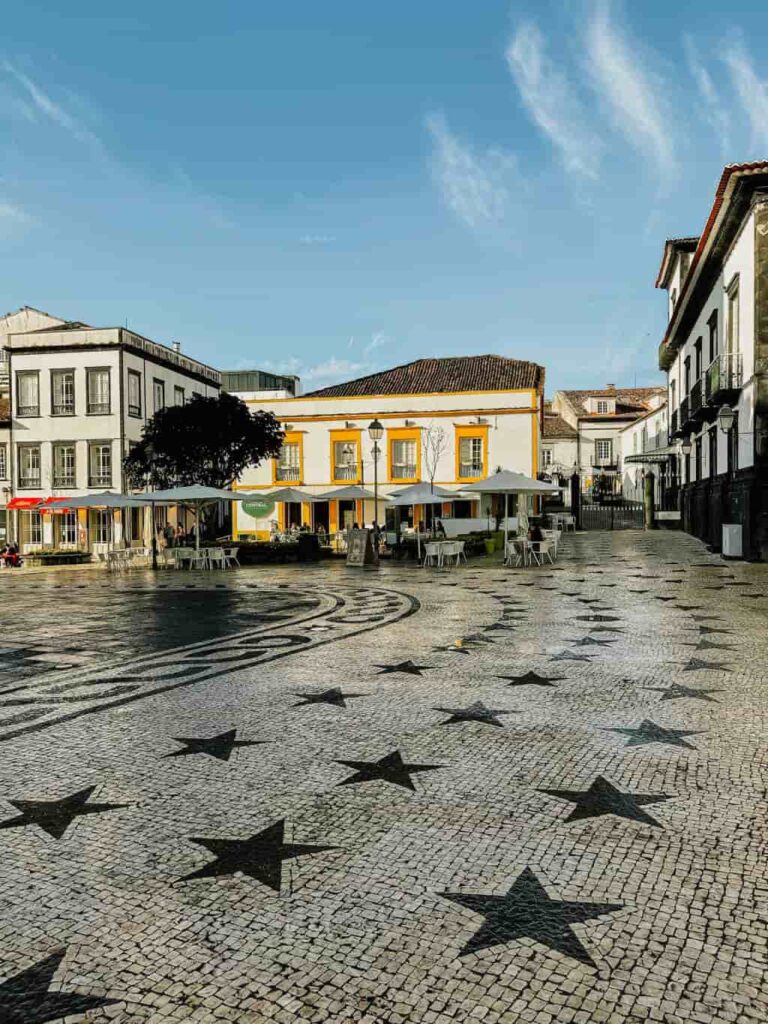
The best time to visit Sao Miguel
Owing to its position in the middle of the Atlantic, Sao Miguel enjoys Goldilocks temperatures, never too hot and never too cold. Winter temperatures are generally around 10-12C and summers see temperatures of around 24-27C.
The Gulf Stream means that the ocean water is never chilly either, averaging 22-24C during the summer and never colder than 16C in the winter, which is significantly warmer than off the coast of mainland Portugal.
In terms of weather, summer is when the island sees the least amount of rainfall. Summer months are, however, also peak season. Because the island is small and tourism infrastructure is still relatively nascent, the busy months of June to August can mean that hotel and car rental availability is low. Make sure to book well in advance.
We travelled in October and enjoyed beautiful weather with lots of sunshine – even though the forecast was rain for the entire duration of our trip! The weather is very unpredictable in the Azores in general so be prepared to change your plans (or work with a travel operator who can do this for you).
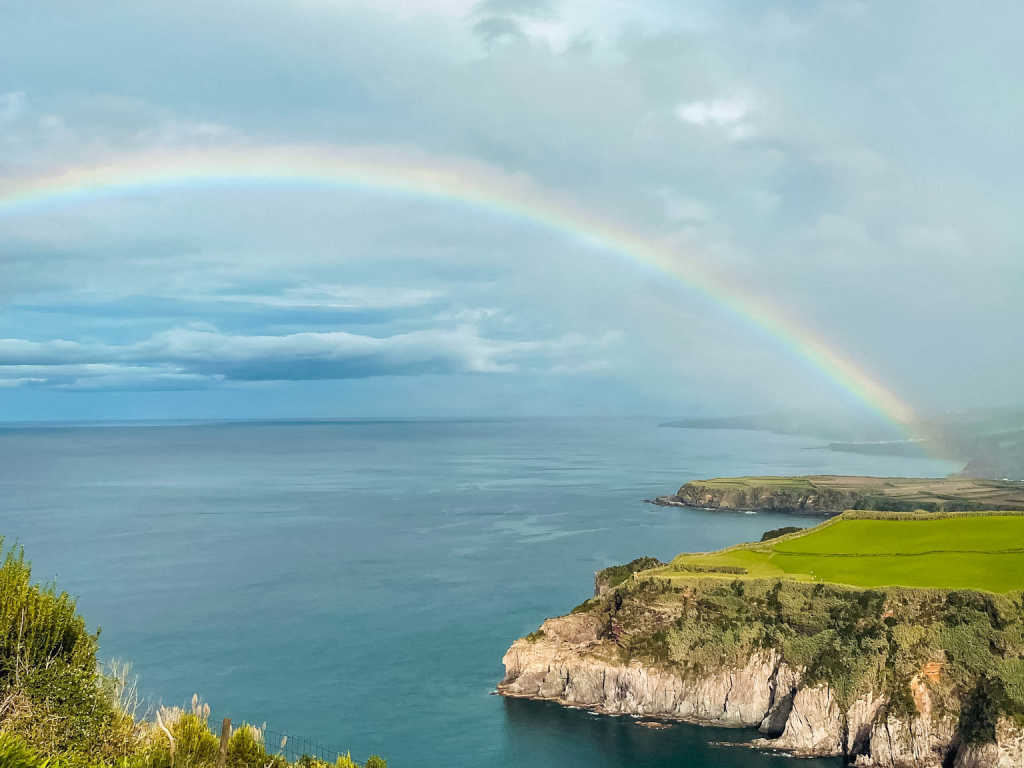
The best things to do in Sao Miguel
The following are some of the best sights, attractions and activities to enjoy on the island of Sao Miguel.
The following destinations and activities are marked in purple on the Google map above.
Ponta Delgada
The island’s capital, Ponta Delgada started life as a simple fishing village before growing during the 17th and 18th centuries, transforming into the colourful city that it is today. There are a handful of sights worth seeing although in all honestly I would limit your time in Ponta Delgada and focus on exploring the rest of the island, especially if you are short on time.
Located near the water in the São Sebastião parish are the Portas da Cidade, the three-arched gate that you’ll see on the city’s coast of arms. The gate, made from regional volcanic stone, forms part of the city’s old defences and dates back to 1783. The surrounding square is very pretty, laid with mosaic tiles (calçada portuguesa).
The Convento de Nossa Senhora da Esperança is one of the most important convents in Portugal. Built in 1545 it today the setting for the largest religious festival in the Azores, held in honour of the Senhor Santo Cristo dos Milagres. Held after Easter, thousands gather to celebrate every year for five days of celebrations.
Other highlights include the old fortress Forte de Sao Bras, now a Military Museum, the Mercado da Graca, the local market and the Jose do Canto Botanical Garden. Don’t miss Azores in a box – Centro de Artesannato e Design dos Acores, a shop selling artisanal products and handicrafts from the Azores.
There is an underground lava cave, Gruta do Carvão, on the outskirts of town. Probably my favourite thing to do in Ponta Delgada was our visit to the pineapple plantation.
There are over 6,000 pineapple plantations on Sao Miguel (the only place in the world where pineapples are grown in greenhouses) but only a handful are open to the public, including the Augusto Arruda Pineapple Plantation in Ponta Delgada. It’s well worth stopping here to see the various stages in pineapple production – a process the takes 18-24 months!
The plantation is open to visitors. An on-site shop sells lots of pineapple related products including pineapple liquor and pineapple jam.
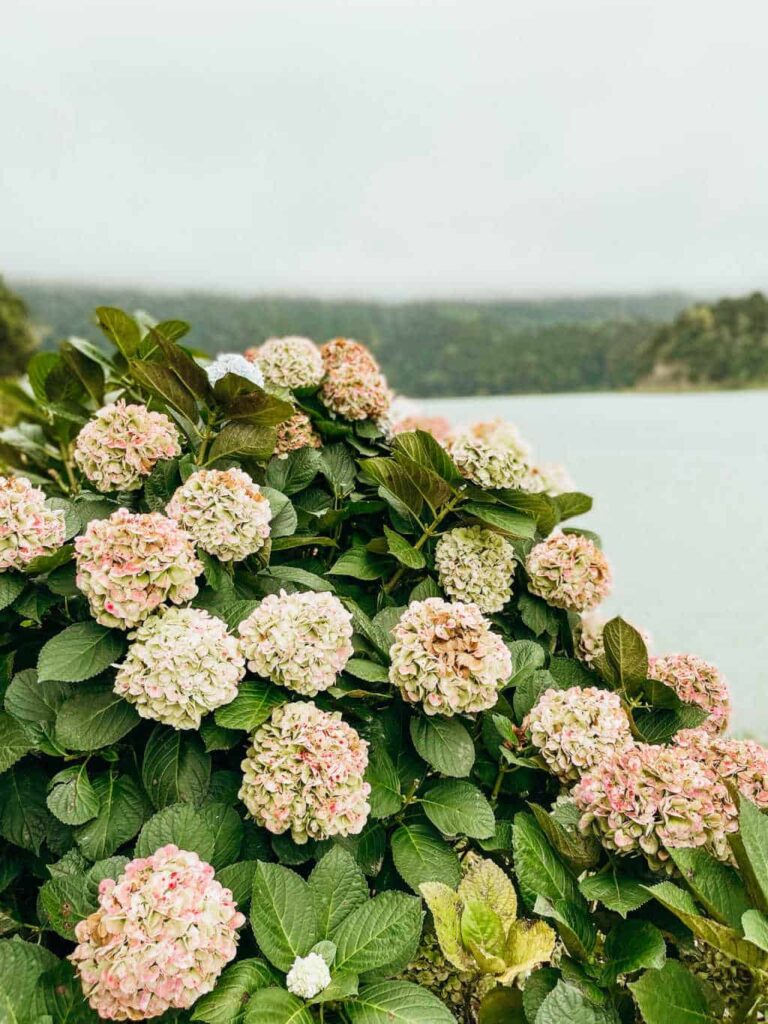
Lagoa das Sete Cidades
Located in the western part of Sao Miguel, the Lagoa das Sete Cidades (the Sete Cidades lakes) is one of the island’s most popular places to visit and for good reason, it’s absolutely stunning. The Blue and Green lakes (Lagoa Azul and Lagoa Verde), are the star attractions here. Although they look like two lakes they are, in fact, one lake separate by a bridge.
Legend has it that a princess fell in love with a shepherd but when her father found out he separated them. Heartbroken, the duo cried enough tears to create the lakes, the green lake made by the shepherd’s green eyes and the Blue lake by the Princess and her blue eyes.
In reality the Green lake looks green owing to the dense, lush vegetation that surrounds it. The Blue lake on the other hand is bigger and deeper, causing it to look more blue.
For the best views of the twin lakes head to one of the viewpoints in area. Miradouro da Boca do Inferno (Hell’s Mouth), Miradouro da Vista Do Dei and Miradouro Pico do Ferro are good viewpoints. Boca do Inferno requires a short walk to get there.
You can hire kayaks and paddle between the two of them but unfortunately swimming is forbidden. This is the same with all the lakes on the island.
Ponta de Ferraria
Ponta da Ferraria, the most western point of the island, is the corner of Sao Miguel that most reminded me of Iceland owing to its dramatic volcanic coastline and basalt arch. What’s particularly special about here, however is the natural swimming pool that sits tucked into the coastline.
This is not just any old pool, however, the water in this natural cove is a combination of geothermal water from a sulphurous hot spring and cold water from the ocean. At low tide you can access the pool via the ladders and bathe in waters that range from 18C to 28C. Different areas of the pool have different temperatures, take care when close to the spring as it can be hot at times.
Moving around the pool can be a little tricky owing to the waves and the rocky seabed but ropes have been strategically positioned to allow swimmers to move around.
Entry is free and there are changing rooms at the pool.
Another way to enjoy the thermal waters is at the Spa Termas da Ferraria. Located close to the parking area, the spa has a pool and offers various treatments using water form the hot springs in the area.
Miradouro de Escalvado
Sao Miguel is peppered with viewpoints from where you can enjoy some of the best island views. Not far from Ponta de Ferraria is Miradouro de Escalvado, a spectacular view point that is particularly good for spotting whales.
The Azores are one of the best places in the world to see whales with sperm whales, sei whales, fin whales, pilot whales and mink whales regularly spotted in the water. Dolphins also inhabit the waters and can regularly be seen swimming along. Blue whales, humpback whales, orca’s, false orca’s, pigmy sperm whales and Northern bottlenose whales can sometimes be spotted passing through the channel that separates the islands.
The whale-watching season in the Azores lasts from April to October, however you can usually spot sperm whales year-round.
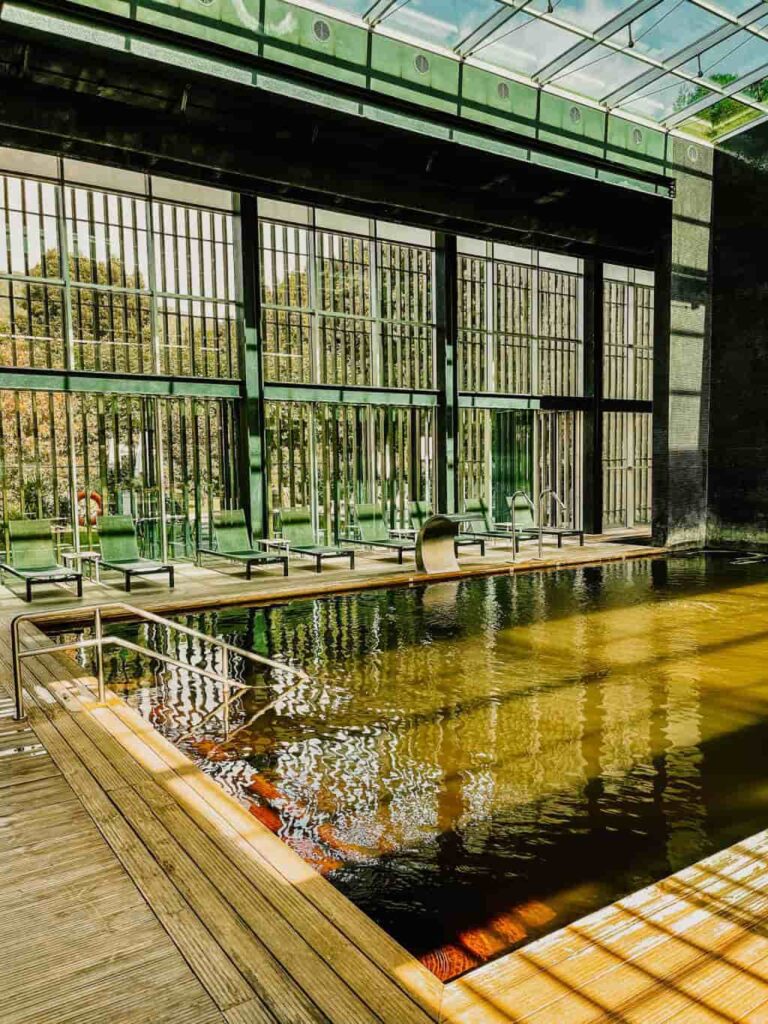
Furnas
Located on the southeast side of the island, Furnas is the oldest tourist destination in the Azores. The Furnas Valley is actually a crater, the remains of a long-extinct volcano. Visitors have been coming here for centuries, tempted by the mineral water and thermal pools thought to help treat a variety of health treatments. Furnas has hundreds of natural springs and streams.
Furnas is also the centre of the island’s geothermal activity. There are two active volcanic sites here where calderas bubble and boil, fumaroles steam and thermal pools are naturally heated to bath temperature.
Furnas is also famous for their cozido, a traditional Portuguese stew that is cooked underground, using the geothermal heat to cook it through.
Cozido
Cozido is a traditional Portuguese stew consisting of beef, potatoes and vegetables, usually cabbage. Cozido nas Caldeiras is the local version. Literally translated as ‘cooked in the boiler’, in Furnas the stew is placed in a hole underground and then allowed to slow-cook thanks to the volcanic heat.
Cozido are often left overnight to cook but you can take your stew in the morning and pick it up 5-7 hours later. At Furnas Lake there is a cozido spot where local restaurants come to have their cozidos cooked – many restaurants have dedicated holes that only they can use.
It’s not only restaurants, however, anyone can turn up with their pot to be cooked and, for a few euros, the two men in charge will dutifully place the pot underground using strong metal hooks. When it’s cooked, they will retrieve it for you too.
We tried Cozido at our hotel, the Furnas Boutique Hotel, and while it was good I think it was the experience that I enjoyed most rather than the dish itself. This is a heavy dish but definitely something that is worth trying while you are in Furnas.
There are plenty of other restaurants in town that serve Cozido including the restaurant at the Terra Nostra Gardens Hotel and Tony’s Restaurant. Note that there is not a cozido restaurant – or any kind of restaurant – at the lake itself.
If you want to enjoy a full day cozido experience then contact EPIC Travel. Their Cozido experience includes visiting the market and local butcher in the morning to buy your ingredients, preparing the cozido and taking it to the lake to cook. The afternoon is spent doing activities before retrieving the cozido and enjoying it for dinner.
Furnas Lake and Caldeiras
You’ll find Sao Miguel’s second-largest lake in Furnas, the Lagoa das Furnas. An easy, flat two-hour circular track runs around the lake (and is appropriately called the Lake Furnas Hike). The entire loop is about 6km long.
To one side of the lake is the Our Lady of Victories Chapel (Capela de Nossa Senhora das Vitorias), a Neo-Gothic church that dates back to 1882. It was built by a local landowner, Jose Do Canto, for his wife who had fallen terminally ill. He was later buried in the Chapel alongside his wife.
The church is surrounded by flower-filled botanical gardens, Mata-Jardim Jose do Canto. The gardens are private property, belonging to the same family today, but they are open to visitors during opening hours for a small fee.
If staying at the Furnas Boutique Hotel, they can arrange for a picnic and BBQ for after your walk. You can also hire kayaks if you want a paddle along the water.
To one side of the lake is Caldeiras da Lagoa das Furnas, the area’s showstopper. This popular spot is where you can spot the famed geothermal activity in action; geysers spout hot water, steam and boiling mud.
There is a car park at the lake, a nominal fee is charged for parking. There is no charge if you arrive on foot.
Miradouro Pico do Ferro
To get a birds eye view of the Furnas Valley then head to Miradouro do Picco Ferro. This viewpoint on a clear day offers unobstructed views over the valley, Furnas Lake, and Furnas town.
This viewpoint is one of the most popular things to do in Furnas so be prepared to share the viewing platform with other tourists, including the occasional tour bus. The parking lot sits just below the viewing platform.
Terra Nostra Park and Garden
The Terra Nostra Hotel is the oldest in the Azores and home to the Terra Nostra Garden.
This magnificent botanical garden was originally planted in 1775 by Thomas Hickling, a wealthy merchant from Boston. In 1848 the property was purchased by the Visconde da Praia, a keen gardener who enlarged and improved the gardens adding water gardens and new species of plant. The gardens changed ownership several more times before being acquired by the hotel when it opened in 1935. The hotel employed gardner John McInroy, who had trained at Kew Gardens in London, to restore the gardens, resulting in the gardens that you see today.
There’s a huge collection of plants from around the world as well as local Azores flora and fauna.
One of the park’s highlights is the large geothermal hot pool. Rich in iron, the waters of this pool are a dark yellow colour so if you want a dip, make sure to wear dark colours so that your swimsuit and towel don’t get stained! The waters are very warm, ranging between 35 – 40C.
The park is open from 10.30am – 4.30pm. There is a charge for entering.

Island of Vila Franca do Campo
The island of Vila Franca do Campo sits opposite the town of the same name, about 1km from the coast. The island was created by an ancient volcano and the crater has formed a natural swimming pool. It’s a certified nature reserve and can only be accessed by boat on a day trip; only 200 people are allowed on the island at any one time and a maximum of 400 people are allowed per day so plan accordingly.
The island gained fame when it held an edition of the Red Bull Cliff Diving world championships. Today it’s perfect for swimming, snorkelling and spotting the birdlife who call the island home. There are no facilities on the island so make sure to bring everything you need with you.
Vila Franca do Campo
The town of Vila Franco do Campo is filled with whitewashed buildings topped with red tiled roofs and coloured wooden shutters, surrounded by banana plantations. It was the first capital of Sao Miguel island until it was destroyed by an earthquake in 1552.
Just outside of the main town on the hillside is the small chapel ‘Ermida de Nossa Senhora da Paz’, which is well worth a visit. This is the perfect place to come for views over town and the island of Vila Franco do Campo. The chapel itself is also very pretty; blue-tiled steps decorated with Christian images and framed by hydrangeas lead up to the chapel itself.
Legend has it that a shepherd looking to shelter from bad weather found an image of the Virgin Mary, which he took to the priest in the parish church. This happened several more times and each time he took the image of the Virgin Mary to the priest, until the community decided that this was a sign from up high and they decided to build a shrine for the image.
Whale and dolphin watching in Sao Miguel
The Azores archipelago are an amazing destination for whale watching. Some 24 different species of whale can be spotted in the waters surrounding the islands including sperm whale, sei whale, fin whale, pilot whale and mink whales.
You’ll also spot a number of dolphins including common dolphin, bottlenose dolphins, Atlantic spotted dolphin, striped dolphin and Risso’s dolphin.
The whale watching season lasts from April to October although sperm whales can be spotted year-round. Visit between April and May and you may be rewarded with a visit from a blue whale. October is when humpback whales are easier to spot.
Not surprisingly, whale watching is one of the most popular things to do in the Azores. Despite its popularity, however, there are strict measures in place to ensure that all whale and dolphin watching tours are carried out in the most sustainable and non invasive manner.
- Tour operators are not allowed to feed the dolphins or whales
- Boats can only approach the mammals from behind and must stay 50m away; if the whales are curious then they can approach the boat
- Only two people are allowed to swim in the water at any one time
- A biologist is always on board
Tours depart from various locations on Sao Miguel including from Ponta Delgada.
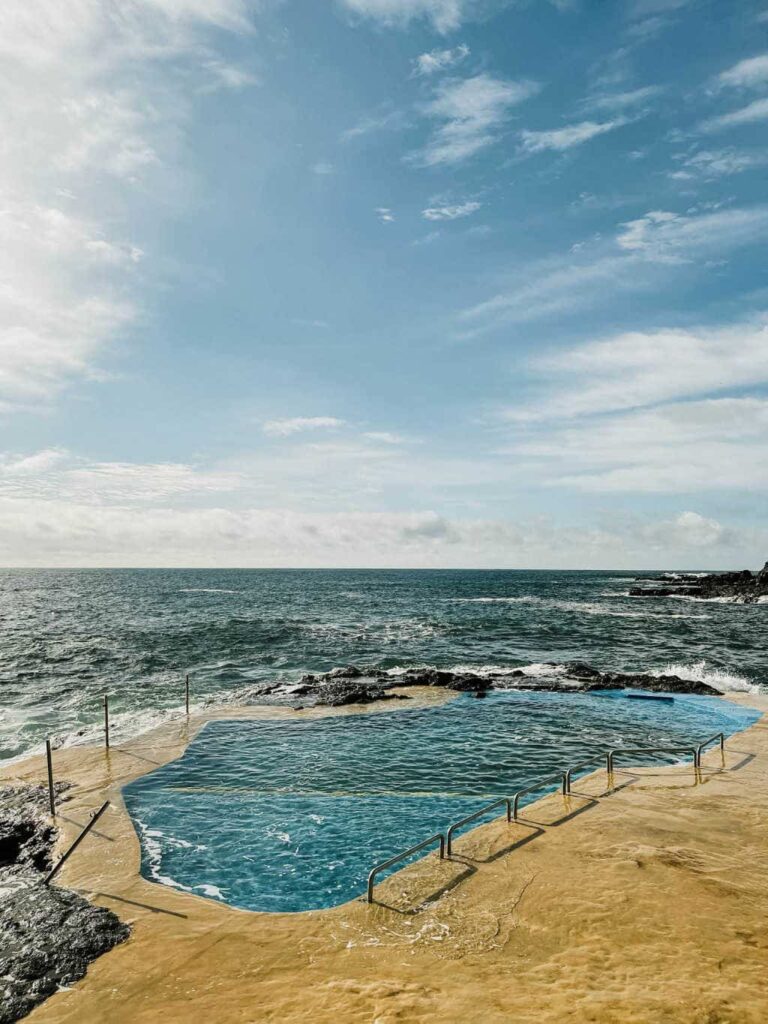
Caloura
Easily one of my favourite places on the island of São Miguel is the small fishing village of Caloura.
This pretty village sits on the middle of the south coast and is famous for its microclimate. The small port is one of the oldest on the island and you’ll regularly spot fishermen on the jetty trying their luck or heading out to sea in wooden boats.
At the end of the jetty, next to a small lighthouse, is a wonderful swimming pool. The small bathing area is filled with sea water and is the ideal place for a dip.
West of Caloura, on the opposite side fo the port, is a small sandy beach known to locals as Praia da Baixa D’Areia. The beach is only 100m long but still boasts some changing rooms and a picnic area with barbecues and tables.
The other reason to come to Caloura is to enjoy the best grilled fish on the island (according to locals!) at Bar Caloura.
We didn’t get to stay very long in Caloura but it will be one of the first places I go back to when I’m next in Sao Miguel.
There is a hotel here, the Caloura Hotel Resort, but we did not get to visit it so I can’t vouch for it personally.
Lagoa do Fogo (Lake of Fire)
One of Sao Miguel’s main attractions is Lagoa do Fogo, Fire Lake. Located in the middle of the island, the crater lake is simply stunning. Measuring approximately 2km long and 1km wide, the lake sits within a caldera formed during a volcanic eruption in 1563.
It’s a protected nature reserve home to various endemic and introduced plant species. It’s also home to a number of birds.
The only way to reach the lake is by foot. The lakeshore does not have car access and unfortunately, swimming in the lake is prohibited.
There are two hiking trails down to the lake. The long hike is an 11km circular hike which the official tourism website of the Azores says is of medium difficulty and takes around 4 hours (longer if you want to spend some time at the lake too).
Make sure you are properly equipped for this hike bringing whatever equipment and food you need with you and remember the the weather can change quickly.
There is a second hike that starts at the Miradouro da Lagoa do Fogo and leads down a steep trail to the lakeshore. This shorter circular hike option is relatively easy; you can get down to the lake in 15 – 30 minutes. Hiking up again will take a little longer.
Whether you choose to hike down to the lake for a different perspective or not you really need to see the lake from up high. There are a number of viewpoints that offer visitors a breathtaking view of the lake – make sure to check the weather forecast and cross your fingers for clear skies!
The two official viewpoints are Miradouro da Barrosa and Miradouro da Lagoa do Fogo. There is limited parking at Miradouro da Barrosa and more parking at Miradouro da Lagoa, which is where you’ll find most of the tour buses.
Caldeira Velha
On your way down from the viewpoints at Lagoa do Fogo, on the main road to Ribeira Grande, is Caldeira Velha where you’ll find a pair of hot springs. The thermal baths are stone-walled and surrounded by rich foliage and beautiful waterfalls that feed into the pool towards the back of the park.
Tickets must be booked in advance to visit, maximum stays of two hours. Again, its’ worth wearing older, darker swim suits as the minerals in the waters can stain your clothes. Adult tickets cost 8 euros.
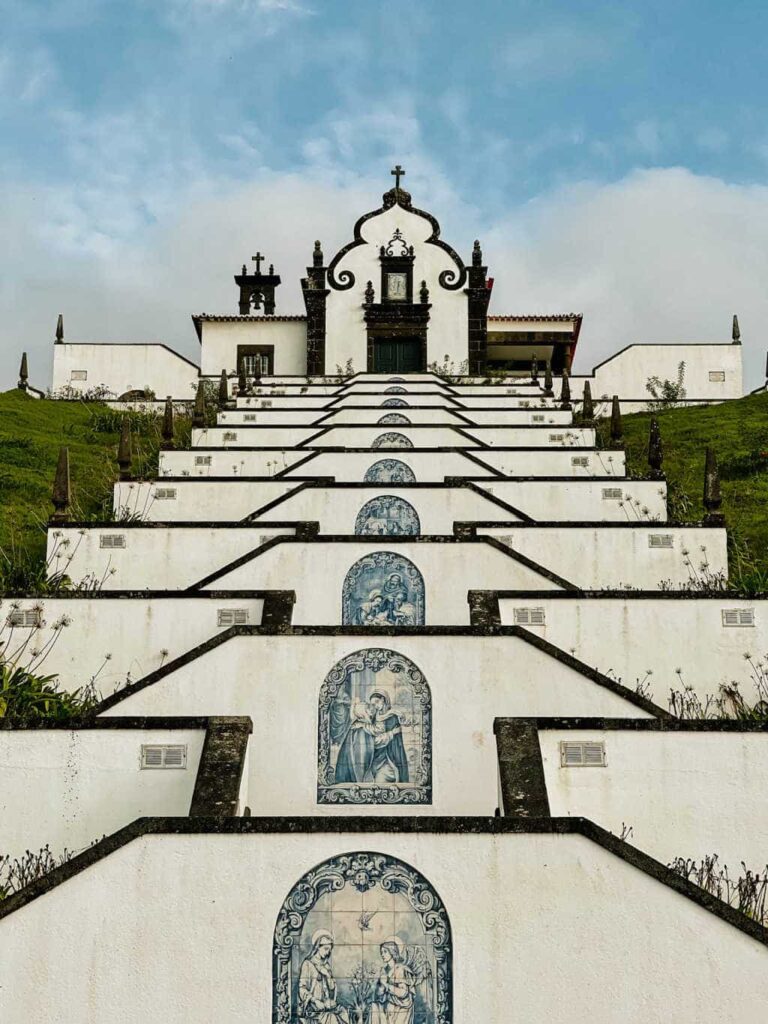
Parque Natural da Ribeira dos Caldeirões
Possibly one of the prettiest corners of Sao Miguel can be found on the north-eastern part of the island (the Nordeste), the Ribeira dos Caldeirões Natural Park. This protected area is home to lush vegetation, waterfalls, beautiful hydrangeas bloom and old watermills. The first beautiful waterfall sits near the parking lot to the park and from here a dirt trail leads up past myriad ferns and cypress trees to another waterfall, which is where some tour operators run canyoning tours.
The park is free to visit and there is a parking lot and a small cafe and shop on site.
Cha Gorreana
Don’t miss visiting Cha Gorreana when you’re in Sao Miguel, currently the only tea plantation in Europe. The family run Gorreana tea factory was first established in 1883 and produces both green and black tea.
At one point there were 62 tea plantations in the Azores, however, only Cha Gorreana is left.
The tea factory is open fo the public and you can wander through the building admiring the original ‘Marshalls’ machinery that dates back to the 1840s. A small shop is on site and there are several walking trails near here too. Visit between April and September and you will see the tea being harvested.
Getting to Sao Miguel
The Azores is one of two autonomous regions of Portugal (the other is Maderia). The islands sit 1,400km (870 mi) west of Lisbon, 1,500km (930 mi) northwest of Morocco and 1,930km (1,200 mi) southeast of Newfoundland, Canada.
The main international airport for the Azores is João Paulo II Airport (PDL) at Ponta Delgada, the capital of São Miguel island, which is the largest island in the archipelago.
From the UK
Ryanair operates a direct flight from Stansted to Sao Miguel every Saturday and from Manchester to Sao Miguel on Fridays during the summer months.
During the summer months British Airways operates direct flights form Heathrow to Sao Miguel on Saturdays and to Terceira on Sundays.
At other times of the year flying from the UK you will have to fly via Lisbon, the capital of mainland Portugal. TAP Air Portugal, the national carrier, operates daily flights from Manchester, Gatwick and Heathrow. You can also fly from Edinburgh, Bristol and Luton airports on selected days.
I flew TAP from London to Lisbon and then onto Sao Miguel (disclosure: my flights were complimentary as part of a media trip) and it was efficient and easy.
From the USA and Canada
There is a direct daily flight from Boston to Sao Miguel on Azores Airlines, which takes less than 5 hours. Azores Airlines also runs daily direct flights from Toronto to Sao Miguel. In May 2022, United Airlines plans to introduce daily nonstop flights between the New York area and Sao Miguel.

